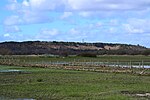Sopley

Sopley is a village and civil parish situated in the New Forest National Park of Hampshire, England. It lies on the old main road from Christchurch to Ringwood, on the east bank of the River Avon. The parish extends east as far as Thorny Hill and borders the parishes of Bransgore and Burton to the south and west respectively. It lies down the road from a small hamlet called Ripley. It includes the hamlets of Shirley, Avon and Ripley. The area is mainly rural with less than 300 dwellings.The village is situated on the fringes of the New Forest, just outside the New Forest National Park but within the perambulation boundary of the forest. Most of the buildings date back to the 19th century but there are more modern houses to the north. It is also home to Moorlands College, one of the largest evangelical theological seminaries in the country. The college was built on the site of the old manor house which was demolished in 1988.
Excerpt from the Wikipedia article Sopley (License: CC BY-SA 3.0, Authors, Images).Sopley
Derritt Lane, New Forest Sopley
Geographical coordinates (GPS) Address Nearby Places Show on map
Geographical coordinates (GPS)
| Latitude | Longitude |
|---|---|
| N 50.772 ° | E -1.7773 ° |
Address
Derritt Lane
Derritt Lane
BH23 8AP New Forest, Sopley
England, United Kingdom
Open on Google Maps








